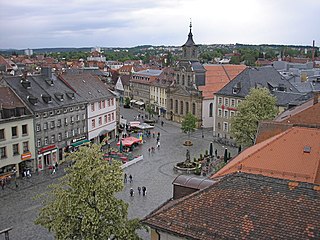
Bayreuth is a town in northern Bavaria, Germany, on the Red Main river in a valley between the Franconian Jura and the Fichtelgebirge Mountains. The town's roots date back to 1194. In the 21st century, it is the capital of Upper Franconia and has a population of 72,148 (2015). It hosts the annual Bayreuth Festival, at which performances of operas by the 19th-century German composer Richard Wagner are presented.

Kulmbach is the capital of the district of Kulmbach in Bavaria in Germany. The town, once a stronghold of the Principality of Bayreuth, is renowned for its massive Plassenburg Castle, which houses the largest tin soldier museum in the world, and for its sausages, or Bratwürste.

Schloss Charlottenburg is a Baroque palace in Berlin, located in Charlottenburg, a district of the Charlottenburg-Wilmersdorf borough.

Schönhausen Palace is a Baroque palace at Niederschönhausen, in the borough of Pankow, Berlin, Germany. It is surrounded by gardens through which the Panke river runs. The palace is maintained by the Prussian Palaces and Gardens Foundation Berlin-Brandenburg and reopened to the public in 2009 after extensive restoration.

Christian Friedrich Carl Alexander was the last margrave of the two Franconian principalities, Bayreuth and Ansbach, which he sold to the King of Prussia, a fellow member of the House of Hohenzollern.

Eckersdorf is a municipality in the district of Bayreuth in Bavaria in Germany.

Schloss Favorite is a Baroque maison de plaisance and hunting lodge in Ludwigsburg, Germany, which was used as a summer residence and hunting lodge. It is located on a rise, directly north of Ludwigsburg Palace to which it is connected via an avenue.

George Frederick Charles, Margrave of Brandenburg-Bayreuth, was a German prince, member of the House of Hohenzollern, nominal Margrave of Brandenburg-Bayreuth-Kulmbach (1708–35) and Margrave of Brandenburg-Bayreuth (1726–35).

Princess Elisabeth Friederike Sophie of Brandenburg-Bayreuth, was a German princess of the House of Hohenzollern and the Duchess of Württemberg by marriage.
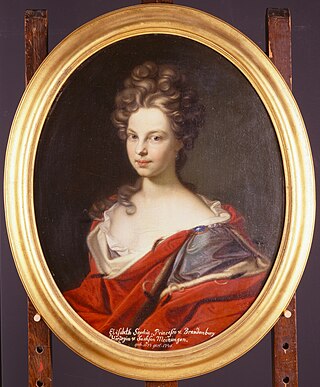
Elisabeth Sophie of Brandenburg, was a Duchess consort of Courland by marriage to Duke Frederick Casimir Kettler of Courland, a Margravine consort of Brandenburg-Bayreuth by marriage to Christian Ernst, Margrave of Brandenburg-Bayreuth, and a Duchess consort of Saxe-Meiningen by marriage to Ernst Ludwig I, Duke of Saxe-Meiningen. She was joint regent in Courland during the minority of her son Frederick William, Duke of Courland from 1698 until 1701.

Moyland Castle is a moated castle in Bedburg-Hau in the district of Kleve, one of the most important neo-Gothic buildings in North Rhine-Westphalia. Its name derives from the Dutch word Mooiland which means "beautiful country". The name was probably coined by Dutch workers, whom the then-leaseholder Jacob van den Eger of the Lower Rhine brought to the property in 1307 to drain the surrounding wetlands.

Oranienburg Palace is a Schloss located in the town of Oranienburg in Germany.
Anna Maria Princess of Eggenberg, née Brandenburg-Bayreuth (born 30 December 1609 in Bayreuth; died 8 May 1680 in Ödenburg) was a Margravine of Brandenburg-Bayreuth and, by marriage Johann Anton I von Eggenberg, a Fürstin (princess) of Eggenberg.
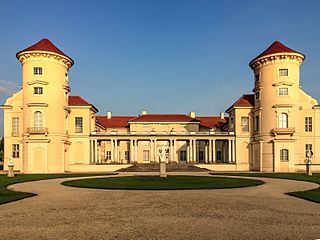
Rheinsberg Palace lies in the municipality of Rheinsberg, about 100 kilometres (62 mi) northwest of Berlin in the German district of Ostprignitz-Ruppin.

Residenz Ansbach, also known as Markgrafenschloß, is a palace in Ansbach, Germany. It was the government seat of the Margrave of Brandenburg-Ansbach. Today it is the administrative seat of the government of Middle Franconia. The Great Hall and the Orangerie in its garden serve as venues for the biennial music festival Bachwoche Ansbach.

Sophia of Saxe-Weissenfels was a German aristocrat and culture patron, Margravine of Brandenburg-Bayreuth by marriage to George William, Margrave of Brandenburg-Bayreuth.
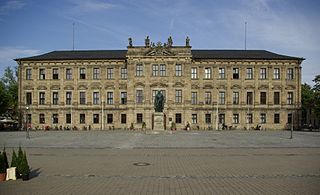
The Schloss Erlangen is a residence in Erlangen, built between 1700 and 1704 by George William, Margrave of Brandenburg-Bayreuth. Work was initially led by Antonio della Porta and after his death in 1702 by Gottfried von Gedeler. It was the first baroque building built from scratch in Franconia.
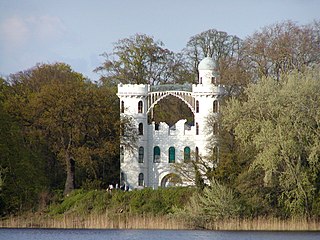
The Pfaueninsel Palace is a Romantic-style building on the shore of the Havel in Berlin. Constructed on behalf of Frederick William II, the Lustschloss was completed in 1797. Today, the palace is a museum of the Prussian Palaces and Gardens Foundation Berlin-Brandenburg.

Sanspareil rock garden is an English landscape garden created between 1744 and 1748 in the village also now called Sanspareil, pronounced locally in German, or the Ostfränkisch dialect as "Samberell". It is in the municipality of Wonsees in the district of Kulmbach, Bavaria.
The old palace is one of the two castles within the historic Hermitage Park to the east of the St. Johannis district of the German city of Bayreuth. The building should not be confused with the Old Palace in the city center.



















